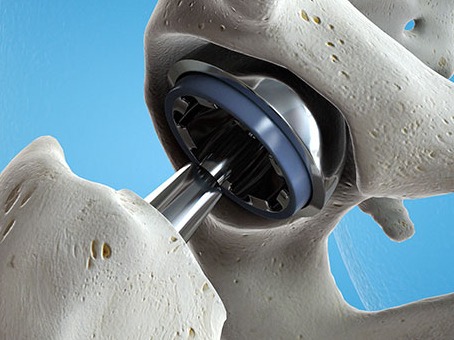SCHEDULE AN APPOINTMENT WITH US
Are Your Symptoms Affecting Your Quality Of Life?
Consult our MOH-accredited orthopaedic specialist for an accurate diagnosis & personalised treatment plan today.

MBBS (S’PORE)
MRCS (Ireland)
MMed (Ortho)
FRCSEd (Ortho)

Hip replacement surgery, also known as hip arthroplasty, involves replacing the damaged cartilage and bone in the hip with metal implants and high-grade plastic components. This surgery helps relieve pain and restore function in patients with difficulty walking.
Hip osteoarthritis is the most common condition that requires a hip replacement. It is an effective and safe procedure that has helped many patients regain mobility and independence.
Patients who suffer from hip osteoarthritis or rheumatoid arthritis may be suitable candidates for a hip replacement surgery. The damaged cartilage in their hip can cause pain and difficulty moving, which will require surgical intervention.
Other symptoms include:
Once all non-surgical treatment options have been exhausted, your doctor may recommend a hip replacement. Your doctor will first examine your hip to check for stiffness, loss of motion, and stability. X-rays of the hip will be needed to evaluate the degree of damage.
MRI scans may be requested if your condition is at an early stage of the disease. A bone mineral density scan is useful for assessing osteoporosis. Once the tests are completed, your doctor will discuss your options for the hip implant and surgical approach.


Depending on several factors, such as the extent of damage to the hip joint, your doctor may recommend different types of hip replacement surgery.
Total hip replacement involves removing the damaged femoral head (ball) and acetabulum (socket) and replacing them with a prosthesis. This surgery is used to relieve pain and restore function in patients with severe hip joint damage.
The direct anterior approach is a minimally invasive technique for total hip replacement. The surgeon accesses the hip joint from the front, working between muscles without detaching them. This approach often results in less pain and a faster recovery compared to the traditional method.
Unlike a total hip replacement, this surgical procedure will only remove and replace the femoral head (ball) with an implant. This surgery is suitable for older patients with femur neck fractures.
The surgical team will advise you on any pre-surgery evaluation tests or fasting that is required. Here is the step-by-step procedure for hip replacement surgery.
A minimally invasive technique for accessing the hip joint from the front.
Before the procedure begins, the patient is administered either general anaesthesia, which puts them into a deep sleep, or regional (spinal) anaesthesia, which numbs the lower half of the body. The choice depends on the patient’s health, preferences, and the surgeon’s recommendation.
A small incision, typically about 3-4 inches long, is made at the front of the hip. This approach avoids cutting through major muscles, which can lead to a quicker recovery and less postoperative discomfort.
Through the incision, the surgeon carefully moves aside the muscles without detaching them from the bones. This muscle-sparing technique provides access to the hip joint while preserving muscle integrity, which is crucial for a faster and less painful recovery.
The surgeon removes the damaged femoral head and acetabulum, the ball and socket of the hip joint. Any remaining damaged cartilage is also excised to prepare the area for the new implant. This step ensures that the new prosthetic components will fit properly and function effectively.
The surgeon then inserts the new prosthetic components. The artificial socket (acetabular component) is placed into the pelvic bone, and the new femoral head (femoral component) is inserted into the thigh bone. These components are secured in place using bone cement or a press-fit technique that allows bone to grow into the prosthesis over time.
After the prosthetic components are in place, the surgeon carefully repositions the muscles and soft tissues around the hip joint. By preserving these tissues during the procedure, the direct anterior approach helps maintain muscle strength and function, facilitating a quicker return to normal activities.
Finally, the incision is closed using sutures or staples. A sterile dressing is applied to protect the wound and promote healing. Postoperative care involves monitoring the patient for any signs of infection or complications and beginning a rehabilitation program to restore mobility and strength in the hip.
Hip replacement addresses and eliminates hip pain from osteoarthritis. Some of these benefits include:
After surgery, patients can stand and walk for longer periods. They regain their independence and are no longer afraid to travel longer distances. It allows patients to continue gainful employment without worrying about hip pain. For retired patients, the surgery allows them to enjoy their retirement and consider activities such as travelling abroad and participation in low-impact sports.
As with any surgery, a hip replacement surgery also has its risks. Although uncommon, it is possible to experience:
SCHEDULE AN APPOINTMENT WITH US
Consult our MOH-accredited orthopaedic specialist for an accurate diagnosis & personalised treatment plan today.
Recovery after a hip replacement surgery can be improved with proper preparations. If you are overweight, keeping in shape before surgery can strengthen your body to move around in crutches easier.
Patients may also meet with their physiotherapist to discuss rehabilitation exercises post-surgery so that you are more familiar with them.
After a hip replacement surgery, mobility may be reduced for a couple of weeks, and patients will require some form of walking aid. To make this transition easier, patients are recommended to prepare their homes so they can move around easily and safely.
Some home preparations include:
Patients will be able to stand and take steps within 24 hours after surgery. Most patients can be comfortably discharged 1 to 2 days after surgery. You will need a walking aid for the first 4-6 weeks as your hip gets progressively stronger.
With consistent physical therapy, patients can return to normal mobility within three months, and mobility will continue to improve afterwards. High-impact activities may not be recommended during the recovery, but low-impact exercises like swimming and walking can strengthen the joint.

According to MOH’s fee guideline, a total hip replacement surgery costs an average of $40,000 at a private hospital. This fee is calculated before deducting your personal insurance plans (Integrated Shield Plans, Medishield Life) and MediSave payouts. The maximum MediSave payout you can obtain for a total hip replacement surgery is $4,650.
Dr Kau is on the panel for most major local insurers. Talk to our team and your insurance agent to understand the out-of-pocket fees required for a hip replacement surgery.

MBBS (S’pore)
MRCS (Ireland)
MMed (Ortho)
FRCSEd (Ortho)
Dr Kau (许医生) is a Fellowship trained Orthopaedic Surgeon with a subspecialty interest in Hip and Knee surgery and has been in practice for more than 15 years.
He is experienced in trauma and fracture management, sports injuries, and joint replacement surgery.
For Singaporeans, Singapore Permanent Residents and Foreigners.
Please speak to our friendly clinic staff about using your insurance plans.

If you have any enquiry, please do get in touch. Leave us a message and we will get back to you shortly.
Modern hip implants last an average of 15 years. For younger patients below 55, the polyethylene component can wear out with time. The construct may require revision and a second replacement later in life.
A hip replacement surgery can take 1-2 hours to complete.
If both hip joints are badly damaged, it is possible to replace them simultaneously, but this procedure is less common. Talk to our doctor to understand if this is a suitable approach for you.
Patients can resume regular activities after 4-6 weeks but full recovery may take several months.
Patients will be able to walk after a hip replacement and mobility will improve as they recover.
Climbing stairs right after a hip replacement will require walking aids but patients will be able to climb normally after 3-4 weeks.